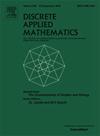正则齐次可追踪非哈密顿图的构造
IF 1
3区 数学
Q3 MATHEMATICS, APPLIED
引用次数: 0
摘要
如果一个图的每个顶点都是哈密顿路径的一个端点,那么这个图就是齐次可追踪的。1979年Chartrand, Gould和Kapoor证明了对于每一个整数n≥9,存在一个n阶的齐次可追踪非哈密顿图。他们构造的图是不规则的。因此,考虑正则齐次可迹非哈密顿图的存在性问题是很自然的。2022年,Hu和Zhan证明了对于每一个偶数n≥10,存在一个n阶的三次齐次可追踪非哈密顿图,对于每一个整数n≥18,存在一个n阶的4阶齐次可追踪非哈密顿图。他们还提出了一个问题:给定一个整数k≥4,确定整数n使得存在一个k阶齐次可追踪非哈密顿图。我们证明了两个结果:(1)对于每一个奇数k≥5,整数p≥6,整数q∈{0,2,4,6},存在一个p(k−1)+q阶的k正则齐次可追踪非哈密顿图;(2)对于每一个偶数k≥6,整数p≥6,整数q∈{0,1,2,3,4,5,6},存在一个p(k−1)+q阶的k正则齐次可追踪非哈密顿图。本文章由计算机程序翻译,如有差异,请以英文原文为准。
Construction of regular homogeneously traceable nonhamiltonian graphs
A graph is called homogeneously traceable if every vertex is an endpoint of a Hamilton path. In 1979 Chartrand, Gould and Kapoor proved that for every integer there exists a homogeneously traceable nonhamiltonian graph of order . The graphs they constructed are irregular. Thus it is natural to consider the existence problem of regular homogeneously traceable nonhamiltonian graphs. In 2022 Hu and Zhan proved that for every even integer , there exists a cubic homogeneously traceable nonhamiltonian graph of order , and for every integer , there exists a 4-regular homogeneously traceable nonhamiltonian graph of order . They also posed the problem: Given an integer , determine the integers such that there exists a -regular homogeneously traceable nonhamiltonian graph of order . We prove two results: (1) For every odd integer , integer and integer , there exists a -regular homogeneously traceable nonhamiltonian graph of order ; (2) for every even integer , integer and integer , there exists a -regular homogeneously traceable nonhamiltonian graph of order .
求助全文
通过发布文献求助,成功后即可免费获取论文全文。
去求助
来源期刊

Discrete Applied Mathematics
数学-应用数学
CiteScore
2.30
自引率
9.10%
发文量
422
审稿时长
4.5 months
期刊介绍:
The aim of Discrete Applied Mathematics is to bring together research papers in different areas of algorithmic and applicable discrete mathematics as well as applications of combinatorial mathematics to informatics and various areas of science and technology. Contributions presented to the journal can be research papers, short notes, surveys, and possibly research problems. The "Communications" section will be devoted to the fastest possible publication of recent research results that are checked and recommended for publication by a member of the Editorial Board. The journal will also publish a limited number of book announcements as well as proceedings of conferences. These proceedings will be fully refereed and adhere to the normal standards of the journal.
Potential authors are advised to view the journal and the open calls-for-papers of special issues before submitting their manuscripts. Only high-quality, original work that is within the scope of the journal or the targeted special issue will be considered.
 求助内容:
求助内容: 应助结果提醒方式:
应助结果提醒方式:


